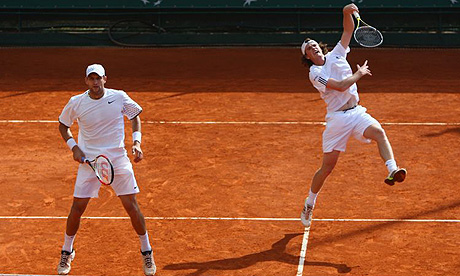Doubles is like a dance. If you are on the same page with your partner and are moving together naturally, it looks beautiful and effortless. However, if you are not on the same page with your partner and your movement is erratic, not only will you look like two kids fighting over a lollipop, but you are guaranteed to be unsuccessful on the court. If you read our last installment on how to pick (and get along with) your doubles partner, then hopefully you have picked the right doubles partner by now. Here are just a few basic tips for how to move on the court with your partner. Implement these and you will be blown away by your new-found efficiency on the court.
Move Together

This may seem simple, but it is much more difficult to actually implement on the court in the heat of the moment. Essentially, you and your partner need to move as a unit. A drill my coach always had us do in college was to connect us with our doubles partner with a band held together with velcro in the middle. Think about it this way, if your partner moves out wide for a forehand, you need to follow them that direction, and by doing so, you will cut off the angle and put yourself in a position to retrieve the reply more easily, and also be in a position to return it more aggressively. If you have or can make these straps, give the drill a shot with your partner in a live-ball scenario. It will feel very awkward at first, but once you get the hang of it and are moving together naturally, you will barely notice that you are connected. Not to mention, anyone that is losing to you while you are tied to your partner is probably going to be quite frustrated, and that’s always fun.
Move Forward
A long doubles rally is about as much fun as you can have on a tennis court. However, that’s not typically what doubles is all about. Doubles is about which team can put themselves in a position to be aggressive and end the point first. That is rarely done from the baseline in doubles. This doesn’t mean crash the net on the second ball every point. It does mean that you need to constantly be thinking about the opportunity to get forward, and taking it at the first reasonably safe chance. While returning, you generally want to get the ball back in play before you think about this, but while serving, it is a good idea to serve and volley on the first serve as much as you possibly can. If you get passed on the return, so be it, but you will put your opponent on their heels and set you or your partner up for an easy winner more often than they will hit a winning passing shot.
Move Aggressively
This goes hand in hand with with the last tip, moving forward. To reinforce: doubles is all about who can be aggressive and end the point first. Naturally, it is a fine line in being aggressive and being stupid. Both will end the points quickly, one in your favor, and the other in you causing unforced errors. If you are moving forward at your earliest opportunities, it will be easy to be aggressive. This is especially important while you are at net, whether your partner is up there with you or not. I learned from an early age, that as the net player, you want to hit EVERY ball that you are capable of taking. Short of diving across the court in front of your partner, chances are if you can poach, or reach any ball at net, you will be taking the offensive, which should be your goal with nearly every shot you hit in doubles.
The intricacies of doubles movements can certainly go much deeper than this, but if you keep these three things in mind, and if your partner does too, then you are already a better doubles player. By moving together, you will defend better, and set yourself up to move forward and move aggressively, setting yourself up to take the offensive and end more points, earlier. Does that sound like it would help your game? If it doesn’t, you’re either lying, or you are a professional doubles player and probably shouldn’t be reading this.
[sc:article_banner_1]


